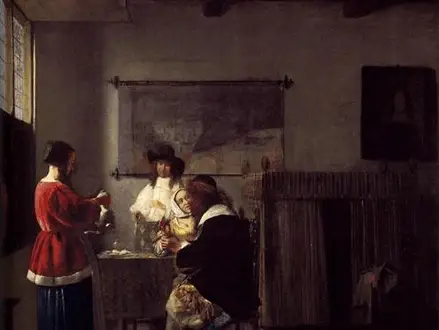Title of Artwork: “The Visit”
Also Known as ‘Merry Company with Two Men and Two Women’

Artwork by Pieter de Hooch
Year Created 1657
Summary of The Visit
The Merry Company with Two Men and Two Women (1657) by Dutch artist Pieter de Hooch is a great example of how popular this type of painting was during the Dutch Golden Age. It shows a group of people who aren’t supposed to be recognized as portraits having fun. It is now at the Metropolitan Museum of Art, New York.
All About The Visit
In 1910, Hofstede de Groot commented about this painting by Hooch, noting, “Two ladies and two gentlemen are seated inside a house in 192. Sm. 34. The party is gathered in the left-hand corner of a room, beside a wide window, the upper half of which is fastened back.
A young woman, dressed in a red jacket with white fur trim, a blue skirt, and a huge white apron, stands at the table’s left corner and pours wine for the guests. A young man in a white suit, complete with a wide collar and a bowler hat, stands behind the table, smoking a pipe, and eyes the girl from behind.
There’s a man to the right of the table wearing a black cape and long curls that obscure his face. He takes the arm of a girl who sits next to them and watches him with a mix of suspicion and amusement on her face. His sloppy cap is in the foreground, off to the right.
There is a curtained bed in the backdrop on the right, a portrait of a guy hanging above it, and a map of a Dutch harbor to the left of the portrait. The direction of light is left. The use of light and color is beautifully done, making for a striking and effective image. Burger thought it was a Vermeer; for proof, see Vol. 14, No. 551 of the 1866 Gazette des Beaux-Arts. Size of the panel is 27″ x 22 1/2″.
Dated 1833 and housed in the library of Baron Delessert (Sm.), The No. 36 Sales Bulletin, Francois Delessert, Paris, May 15, 1869 (150,000 francs). Paris, France, 5 April 1883: B. Narischkine (160,000 francs). A Secret Meeting in Paris on July 1st, 1889 cost 270,000 francs. After that, it ended up in Paris with Durand-Ruel. “Currently on display in New York’s Havemeyer collection.”
Information Citations:
En.wikipedia.org, https://en.wikipedia.org/.
























